Cara Gilger's Blog, page 10
March 18, 2020
To Find a Steady Center: Yehunda Amichai
From the place where we are right
Flowers will never grow
In the spring.
The place where we are right
Is hard and trampled
Like a yard.
But doubt and loves
Dig up the world
Like a mole, a plow
And a whisper will be heard in the place
Where the ruined
House once stood.
-The Place Where We Are Right by Yehuda Amichai from How Lovely the Ruins
I have been both surprised and not at how vehemently people have doubled down on shifting information. We are funny creatures, humans in the internet age. We seem to cling to certainty with a vicious grasp the more uncertain things become around us. Our need to be certain when not much really ever is has hardened us to learning new things, to hearing one another and being open to new information and experiences. Much is changing and likely much will continue to change even after this time.
Today I am taking a deep breath, I am exhaling and I am acknowledging that I cannot know it all with certainty. I will practice being informed by not anxiously collecting information to create certainty I cannot hold.
I am hoping that in this breathing and boundaries around information I can leave the ground less trampled, softer to plant seeds and see something good, maybe flowers, spring up in me and you in this time.
To Find a Steady Center is a daily poem and meditation to offer a short, good word to those who are anxious, fearful or lonely and who might need a gentle word of hope, encouragement or perspective during social distancing.
March 17, 2020
To Find a Steady Center: Wendell Berry
I will go among the trees and sit still.
All my stirring becomes quiet
around me like circles on water.
My tasks lie in their places
where I left them, asleep like cattle.
Then what is afraid of me comes
and lives a while in my sight.
What it fears in me leaves me,
and the fear of me leaves it.
It sings, and I hear its song.
Then what I am afraid of comes.
I live for a while in its sight.
What I fear in it leaves it,
and the fear of it leaves me.
It sings, and I hear its song.
After days of labor,
mute my consternations,
I hear my song at last,
and I sing it. As we sing,
the day turns, the trees move.
-Wendell Berry from This Day: Collected & New Sabbath Poems
To shed your fear you must first sit with it and acknowledge it. I like to talk to my fears like a pestering child, calm and patient, I will say “thank you for alerting me to something that you are concerned about right now. You are right, that is scary. You are right, there is a lot unknown right now. I appreciate you, but you may not be in charge of my day or my heart.” This poem from Wendell Berry reminds me that I can sit with my fear and my fear can sit with me, but that I cannot lose the song of my own heart. That is the song that needs to steady and shape my days. I don’t have to be a farmer (like Berry) or live in the woods (although I would love to) to take a moment to sit and name my fears, to acknowledge their presences and weight and to listen quietly for what is true and steady.
Be kind,
Cara
To Find a Steady Center is a daily poem and meditation to offer a short, good word to those who are anxious, fearful or lonely anh who might need a gentle word of hope, encouragement or perspective during social distancing.
March 16, 2020
Writing Letters: Connection and Care in the Time of Covid-19
This week our children are on extended Spring Break due to the social distancing recommendation to keep our beloved communities safe. Since we both work from home and juggle the kids on the occasional school holiday we are feeling pretty confident we can keep them engaged with learning and occupied safely and sanely. Instead our concern as a family is centered around our community. Worship has moved to online streaming, in person activities have been cancelled and while we are old semi-pros at this we are worried about those that do not thrive in isolation. Seniors and single adults that may find this time with limited interaction difficult. We want to figure out ways to love our neighbors without spreading germs.
So we have decided that we are going to write letters.
Old fashion, snail mail, stick a stamp on it letters. We are working on letters (to practice our writing, sentence structure and storytelling) and drawings (fun!) to stick in the mail to some of the older adults in our church, our community and family. We are even including some of our friends with kids that may need the brief entertainment of going to the mailbox and reading a fun or silly letter. I found a few packs of stickers that we can stuff the envelopes with for our fellow families.
It may seem like a small way to connect, but I figure by the time the mail arrives in a few days people will be experiencing peak loneliness. And who doesn’t love going to the mailbox and finding real mail instead of bills or junk mail?!
Here are some of the writing prompts and ideas I will be giving my kids:
Write about your weekend.
Draw a picture of your family.
Tell about your favorite thing to do at the park.
What is the one thing you love to pretend?
Draw a picture of you and the letter recipient.
What are your favorite snacks and why?
Draw a picture of your favorite snack
What is your favorite animal and what facts can you share?
Draw a picture of your favorite animal
Write about your favorite things to do at home
Make a book recommendation to the letter recipient.
We are hoping that through this small little act we can create connection in our community and share our love (with safe social distance).
Drop some of your ideas for prompts in the comments so we can share!
Like what you’ve read? Want more? Sign up for my twice a month newsletter (because we’re not spammy) and get original content you can’t find here on the blog. Reflections on faith and living, book recommendations and other good, nerdy fun. Sign up HERE.
To Find a Steady Center: Marge Piercy
To have without holding
By Marge Piercy
Learning to love differently is hard,
love with the hands wide open, love
with the doors banging on their hinges,
the cupboard unlocked, the wind
roaring and whimpering in the rooms
rustling the sheets and snapping the blinds
that thwack like rubber bands
in an open palm.
It hurts to love wide open
stretching the muscles that feel
as if they are made of wet plaster,
then of blunt knives, then
of sharp knives.
It hurts to thwart the reflexes
of grab, of clutch ; to love and let
go again and again. It pesters to remember
the lover who is not in the bed,
to hold back what is owed to the work
that gutters like a candle in a cave
without air, to love consciously,
conscientiously, concretely, constructively.
I can’t do it, you say it’s killing
me, but you thrive, you glow
on the street like a neon raspberry,
You float and sail, a helium balloon
bright bachelor’s button blue and bobbing
on the cold and hot winds of our breath,
as we make and unmake in passionate
diastole and systole the rhythm
of our unbound bonding, to have
and not to hold, to love
with minimized malice, hunger
and anger moment by moment balanced.
A few years ago I tried to memorize several poems. I was mildly unsuccessful perhaps because my iPhone and internet addled brain can no long do that work well, perhaps because I am no longer a school aged child. Since then I have discovered the poems that want to lodge themselves in your heart do just that. It takes no effort of memorization or rehearsal. That is how the first lines of Piecy’s poem are for me. “Learning to love differently is hard, love with the hands wide open, love with the doors banging on their hinges.” I want to not be the worried mom, the mom with nerves and I think I wear it deceivingly well to those who are not in my most intimate circle. But I am. I am a nervous mom, worrying about this outcome and that, weighing this risk and that. It was Piercy’s lines that gave me the mantra to think about motherhood differently. To love with my arms open, allowing the doors to flap on the hinges as I teach my children to live in the world.
And now, once again I am worried what will become of the people I love, not just my children or parents, but my low income neighbors with childcare bearing on them and less hours to work as the economy comes to a halt. I worry about my neighbors with medically fragile people in their care that need Chlorox wipes for the maintenance of their daily life, now without the resources they need. And this poem comes to me again reminding me that what we have we ought to hold lightly. There is enough if we learn to love with our hands wide open. Love is a force that can make us selfish with the care of ourselves and our family but love is also a resource that can help us look beyond ourselves and care for others as well as ourselves.
Be kind,
Cara
To Find a Quiet Center is a daily poem and meditation to offer a short, good word to those who are anxious, fearful or lonely anh who might need a gentle word of hope, encouragement or perspective during social distancing.
March 15, 2020
Introducing: To Find a Steady Center
Hello dear ones, I have been thinking over the past few weeks about what I can offer in the midst of this moment. At my heart I am a pastor who cares deeply for the souls of people and I am a writer that finds words to be a source of comfort and wisdom in almost every situation. What can I offer that will be a steadying presence to our spirits, yours and mine? I seem so small, and yet, I cannot help but want to do something.
I prayed about it. And listened. And listened again because I am a little hard of hearing when I am anxious and God is patient enough to stick with me.
That is how it always works.
And so my daily offering to this community of people who love books and the written word and are always curious what God is up to in their life and in the world will be simple. I will be here each early morning with a poem and short meditation.
Poetry for me has always been a source of grounding and calm, a steady voice of wisdom and insight into the human soul in uncertain moments. I have found when I do not have the words, I can trust the poets and mystics of each time to speak the language of the heart. I trust that if poetry can speak to me in other times, it still has a word now. With it I will offer a brief meditation–reflecting on the poem, a word of encouragement, a good word for the day, and cultivating of sacred curiosity (my best and only tool for awe and wonder and hope).
I am hoping to provide a steady center for me, for you, for us. A few words in the morning to remind us we are connected and loved. I hope you will join me.
Blessings,
Cara
Like what you’ve read? Want more? Sign up for my twice a month newsletter (because we’re not spammy) and get original content you can’t find here on the blog. Reflections on faith and living, book recommendations and other good, nerdy fun. Sign up HERE.
February 28, 2020
Winter Reading Recap 2020
I enjoy rounding up what I have read on a seasonal basis because some a lot and some months I need to write deeply and binge the newest series on Netflix. This winter (December, January and February) I read X number of books. You can check out my 2019 Fall Round-Up and 2019 Summer Round-Up if you love book lists.
One thing I am hoping to do with these round ups is create some transparency with how I read as much as I do—where I get my books and how I consume them. Hopefully it gives a clearer picture of how I read for those of you who have either expressed curiosity about how I manage to read so much or interest in increasing how much you read. So to that end along with the title and author I have added the format in which I consumed each book—hardcopy, digital library loan, audiobook—as well as the length of the book. All of my audiobooks are free from the library app Libby. I really do hope that by including these two new details to create some transparency that is both honest and encouraging.
I tried last roundup organizing what I read into fiction, non-fiction and poetry to see how my reading is dispersed. I still really love this way of organizing what I’ve read because it helps me see a larger picture of what I’m consuming and what might have been missing from a particular season of reading.
So without further ado…here are the books I read this winter season of December, January and February:
Fiction
 The Dearly Beloved by Cara Wall
The Dearly Beloved by Cara Wall Format: Hardcopy; Length: 352 pages
In all my years of reading I have never fallen in love with a book based off the blurb in the front jacket or cried during the prologue. The Dearly Beloved follows two couples in ministry as they negotiate their faith, marriage and friendship over the course of several decades. Wall delivers a book that is tender without being saccharin or sentimental, thoughtful without being preachy. She captures the motivations and nuances of the calling of ministry beautifully. This may be one of my favorite books ever, I already want to re-read it.
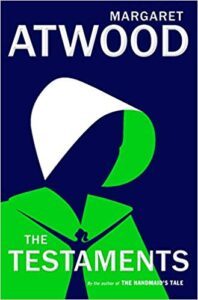 The Testaments by Margaret Atwood
The Testaments by Margaret AtwoodFormat: Library Digital Copy; Length: 432 pages
I wasn’t wild about The Handmaid’s Tale, I think there are better books out there that look at gender, patriarchy and the future (The Power by Naomi Alderman for one). But The Testaments got rave reviews by people I trust so I was curious what it offered beyond the first book and the television show and how, perhaps the success of the television series might have influenced Atwood’s writing. Given that my expectations were low, I was pleasantly surprised to have discover an interesting tale focusing on one of the antagonists from the first book, giving us a glimpse of Gilead further in the future and flashbacks to its beginnings. On the whole it was enjoyable and entertaining to read, although I still found it lacking in its ability to provoke the moral imagination.
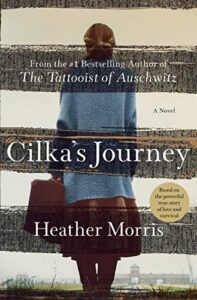 Cilka’s Journey by Heather Morris
Cilka’s Journey by Heather Morris Format: Audiobook; Length: 11 hours
I read this via audiobook from the library over the holidays. I came into it with middling expectation given I was underwhelmed with The Tattooist of Auschwitz and this particular book follows the story of a secondary character from that book. However, I was wrong to have lowered expectations. I immediately found Cilka’s Journey a stronger read following Cilka from the liberation of Auschwitz Birkenau to a second internment at a gulag in Siberia. Through flashbacks you learn about Cilka’s life before WWII and her life in the German concentration camps and how it shapes her present serving out a term for aiding the enemy. It wrestles with what it means to be a woman, survive Auschwitz and to be judged for your survival. It also deals with friendship and self-forgiveness thoughtfully and with nuance. I found it to be moving and complex. I do think that there ought to be a TW on the book for sexual violence because that plays as one of the major themes in the book.
 The Nickel Boys by Colson Whitehead
The Nickel Boys by Colson Whitehead Format: Hardcopy; Length: 224 pages
This book was not fun, but it is an important read. We read for lots of reasons–for adventure, perspective, to feel good–but I find it important to read to be made uncomfortable, to think, to know things that are easier to not know. The Nickel Boys tells the story of Elwood who is sentenced to the brutal childrens school/prison in Florida after hitching a ride in the wrong car on his first day of community college. I learned about a part of recent US history that I wasn’t taught in school through Whitehead’s moving and brutal portrayal of the racism and brutality of mass incarceration of children.
 Red at the Bone by Jaqueline Woodson
Red at the Bone by Jaqueline Woodson Format: Audiobook; Length: 4 hours
I listened to Red at the Bone last week and deeply enjoyed this multigenerational story. Weaving together the story of the destruction of Black Wall Street in Tulsa, OK with a modern day story of the dreams parents hold for their children and the small rebellions of children that often have greater consequences Woodson tells the tale of a family on their daughter’s 16th birthday. I could not pause this story it was so engaging. Each of the narrators was emotionally engaging and fascinating, creating an experience that was both gentle and sharp. Being such a short read not a word was wasted, not a story went without serving the whole. I appreciated that much of the story spins from the consequences of the destruction of Black Wall Street, a story in American history often not told. If you loved Brit Bennett’s The Mothers this will give you the same interesting characters and generational family story vibe.
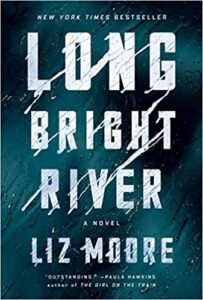 Long Bright River by Liz Moore
Long Bright River by Liz Moore Format: Hardcopy; Length: 496 pages
Mickey is a patrol officer in the Kensington neighborhood of Philadelphia. A neighborhood known for and ravaged by heroin, Mickey’s sister after succumbing to the undertow of addiction is now missing and there’s a sudden rash of deaths in the neighborhood that don’t look like part of the usual overdose deaths. A quick paced and fascinating read, Moore looks at the gritty and heartbreaking effects of addiction without turning it into trauma porn, dealing with the subject matter and her characters with dignity, respect and nuance. Plus she can write one heck of a cop/detective thriller/mystery. Highly recommend Long Bright River if you like a good mystery meets family drama.
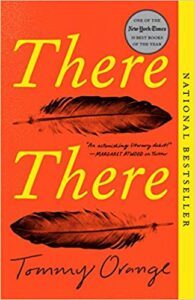 There There by Tommy Orange
There There by Tommy Orange Format: Audiobook; Length: 7 hours
An immersive exploration of what it means to be a contemporary Native American, Tommy Orange leads us through interwoven stories of identity, origin, family and mythology to deliver something truly unique, at least to my reading palette. Set mostly in Oakland, California There There tells the story of several characters as they prepare for and attend the Oakland Powwow, a gathering to celebrate and educate Native identities. Powerful, moving and heartbreaking. I listened to this one on audiobook after the hard copy had sat on my shelf for a few months. I can’t say why I waited but I’m so glad I picked it up. As someone who grew up in Oklahoma, where we learned about the forced relocation and genocide of Native peoples I found Orange’s book a powerful look at a people we prefer to think of as in the past, rather than a people living in the present, grappling with the past. I love a book that delivers something unexpected and Orange truly does that in the larger themes of this book.
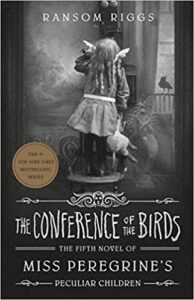 The Conference of the Birds (Peculiar Children #5) by Ransom Riggs
The Conference of the Birds (Peculiar Children #5) by Ransom RiggsFormat: Kindle; Length: 336 pages
This is the story of how one $1.99 Kindle deal five years ago can suck you into a whole series. This is also a story of how you can think you are signing onto a 3 book arc and then the author and publisher keep on going with the same world and characters. I loved the original three books from the Peculiar Children’s series, but The Conference of the Birds was underwhelming and left me asking “why am I still invested in this series? What’s at stake and why do I care about this world and characters now?”
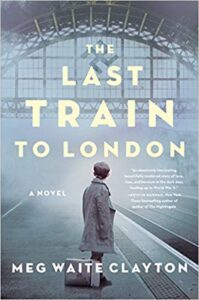 The Last Train to London by Meg Waite Clayton
The Last Train to London by Meg Waite ClaytonFormat: Digital Library Book; Length: 450
I used to love WWII historical fiction, but I am increasingly growing weary of the genre not only because many of them follow the same themes but I am also aware of how the popularity of the genre is really a grappling with white violence and racism and the need for white people to make meaning of the darker impulses of racism. Yeah, that’s where I am at. However, I found The Last Train to London an interesting take on the genre because it explores the themes of childlessness and womanhood, friendship and shifting power. Did this book ease my concerns for the genre? No, but it was a fresh take on this time in human history that allowed space for nuance.
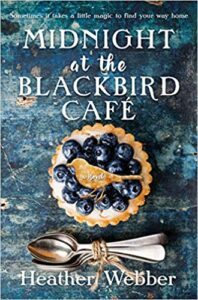 Midnight at the Blackbird Cafe by Heather Webber
Midnight at the Blackbird Cafe by Heather WebberFormat: Audiobook; Length: 12 hours
Sometimes I end up reading books because they are available on Libby, the library app. I need something to listen to and I scroll the available titles and ta da! Due to the mix of available titles I end up listening to books I might not normally select, which is how I ended up reading Midnight at the Blackbird Cafe a story of family inheritance with a bit of magical realism. A story that follows a woman on the verge of attending medical school who is required to manage her deceased aunt’s cafe for three months in order to receive her inheritance. This was a sweet and delightful story about small town life, family history and living the life you want rather than the life that’s expected.
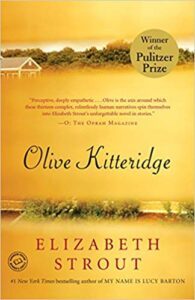 Olive Kitteridge by Elizabeth Stroud
Olive Kitteridge by Elizabeth Stroud Format: Audiobook; Length: 12 hours
This Pulitzer Prize winning novel has been on my radar for quite some time and with the release of Olive, Again, I thought I would pick up Olive Kitteridge. Following the lives of the residents of Crosby, Maine, Stroud intersects the tender and mundane and somehow Olive, a gruff retired school teacher finds herself in the middle of small town life. I wanted to like this book, however, I found the audiobook hard to follow because the book switches point of view but the same narrator/reader was used the entire story which made the switch in POV and the many characters had to track. This is the perfect example of how investing in multiple narrators can help the story come alive or make it difficult to follow and become a distraction. I also didn’t realize this is a collection of short stories loosely tied together by the commonality of the town and not much more. Olive who features heavily in many stories is ultimately a character that has no epiphany or change of heart–she remains gruff and unreflective to the end.
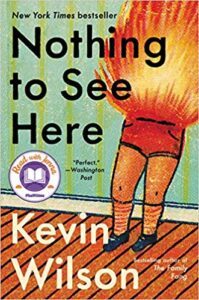 Nothing to See Here by Kevin Wilson
Nothing to See Here by Kevin Wilson Format: Hardcopy; Length: 272 pages
Darkly funny books are too few in my opinion, so I completely enjoyed Nothing to See Here for its quirkiness and snark. It follows the story of a young woman who is lost and adrift when a complicated childhood friend calls and asks her to come help her. The task is to take care of her two step-children that spontaneously combust when they get upset. As I mentioned in a previous post, when this book was released I didn’t think it was something I would find interesting. Magical realism is a tricky genre because it can be too obscure or ask you to suspend too much reality without being full on fantasy. However, in Nothing to See Here Wilson asks you to suspend just the right amount of reality and replaces it with magic that is metaphorically so close to what’s real it’s believable. This book clocks in on the short side at 272 pages and so I deeply appreciate the way Wilson gets down to business—5 pages in and the protagonist is presented as likably flawed, someone that makes mistakes, is a little immature but that you want to see succeed. It takes good writing to pull that off so succinctly. Quirky, quick witted and insightful, I highly recommend this one.
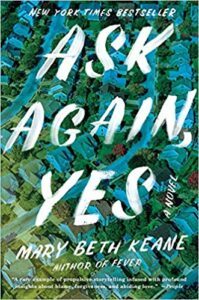 Ask Again, Yes by Mary Beth Keane
Ask Again, Yes by Mary Beth Keane Format: Hardcopy; Length: 390 pages
Where to start with this multi-generational family drama? Do I start by telling you about the last multi generational drama I tried to read but couldn’t get into despite rave reviews? Do I start with praise for how Keane opens the book and immediately invests you in Peter’s struggle to live in a world shaped by his mother’s mental illness? Or should I start with the dynamic between the Gleesons and Stanhopes, two neighboring families that struggle to connect while living only feet apart from one another on their suburban street? For me, family dramas can be hard to get into—why should I care about THIS particular family and the nuance of their unique struggle? Why is their mundane struggle worthy of my investment as a reader? Often I find that authors don’t give you enough to hook into and become invested but that’s not the case with Keane. In Ask Again, Yes Keane gives you characters that are complicated but engaging and a story that moves at a solid clip. I immediately wanted to root for Peter and was drawn to the sparkle of Kate’s spunky personality. I understood Lena’s attempt to be a good neighbor and what it felt like to be shunned. She also avoids getting bogged down in the inner musing of her characters and instead puts them in situations that show their head space by how they work through their situations which I appreciate in family drama writing. I also resonated with the theme of forgiveness in this book—how time can soften anger and give perspective. Forgiveness was handled thoughtfully without resorting to cliche or easy resolution.
 A Woman Is No Man by Etaf Rum
A Woman Is No Man by Etaf RumFormat: Audiobook; Length: 10 hours
A powerful and unflinching look at gender, power and immigration, A Woman is No Man tells the story of three generations of Palestinian women in America struggling against the conventions of Arab culture. I found this book incredibly difficult to read because one of the main themes that runs through the book is the role of domestic violence in asserting domestic power over women. Although I appreciated that the book was written by an own voice author who grew up as a Palestinian American immigrant, it made me more comfortable with the subject matter and the way that Arab culture was portrayed. It was also a helpful reminder that there are still women who are socially isolated, cut off from education, economics and communal support.
Non-Fiction
 Killer of the Flower Moon: The Osage Murders and the Birth of the FBI by David Grann
Killer of the Flower Moon: The Osage Murders and the Birth of the FBI by David Grann Format: Audiobook; Length: 9 hours
Growing up in Oklahoma our study of state history was intertwined with the forced relocation of Native peoples and genocide, so while Killer of the Flower Moon has been on my TBR list for a while, I knew when I read it I would need to be prepared for a story laced with cruelty, racism and indifference towards native language peoples. What I was not expecting was the deeply personal stories that Grann was able to immerse the reader in to show in specifics that larger scope and stakes of how oil wealth became a source of danger for the Osage people, who at one time were some of the richest people in the US. While Grann’s story telling lacked the quick paced and sharp edges that I like in non-fiction, I deeply appreciated that the publisher invested in multiple readers to help listeners understand point of view and voice in the book.
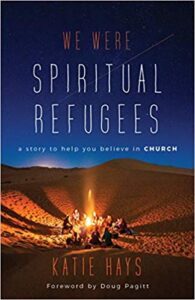 We Were Spiritual Refugees: A Story to Help You Believe in Church by Katie Hays
We Were Spiritual Refugees: A Story to Help You Believe in Church by Katie Hays Format: Digital ARC; Length: 360 pages
I had the chance to read an advanced copy of We Were Spiritual Refugees and it was equal parts entertaining and informative. WWSR is an account of what the church might look like in the future—relationship (rather than institution) centered, no bullshit, embracing of all God’s beloved children. Several times I caught myself thinking “I would LOVE to be a part of this church.” In other words, it gave me hope. You can read my full review HERE.
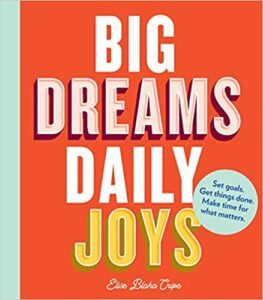 Big Dreams, Daily Joys by Elise Blaha Cripe
Big Dreams, Daily Joys by Elise Blaha Cripe Format: Hard Copy; Length: 175 pages
I have been following Cripe on social media for years (ok, I actually followed her pre-IG back in the blogging days of the mid-to-late 2000’s) before she developed her goal tracking products or even her #make29 project. She is one of the bright, helpful and gracious parts of the internet and social media. I use her tools (goal tracker and get to work book) and appreciate her “try, make mistakes, learn, try again” approach to entrepreneurship, creativity and life. So when Big Dreams, Daily Joys came out I thought I would give it a quick skim and glean some tips. I found it to be accessible without being fluffy and I came away with clear, actionable practices that were not too idealistic or require you to live the perfect life to be able to accomplish.
 The Salt Path by Raynor Winn
The Salt Path by Raynor WinnFormat: Audiobook; Length: 10 hours
This book popped up on the periphery of my radar a few times last year so when I spotted it on my library app I placed a hold. Sometimes finding the next delightful read is as simple as that. The Salt Path follows Winn and her husband as they hike the coast–not on holiday but because they have recently lost their farm and are homeless. Following their poverty and survival with wit and insight, Winn gives you not a sweeping biography but a stunning and insightful sliver of her life at a particular time. The Salt Path is one of those rare biographies that is so grounded in a sense of place and a specific moment that it captures you instantly into the lives of the writer.
 The Witches Are Coming by Lindy West
The Witches Are Coming by Lindy WestFormat: Audiobook; Length: 6.5 hours
“This is a witch hunt. We are witches and we are hunting you” goes the hook in The Witches are Coming the newest collection of essays by Lindy West. Author of Shrill and creator of the subsequent show by the same name, West delivers another volume of essays intersecting pop culture, feminism and political critique in this equal parts gracious, funny and searing read. I particularly enjoyed her essay examining whether or not Adam Sandler movies are actually funny (and what they taught men) and her essay on why we find Ted Bundy charming but not Elizabeth Warren is the essay I needed in my life this political season.
Poetry
 Survival is a Style by Christian Wiman
Survival is a Style by Christian Wiman Format: Hardcopy; Length: 112 pages
Christian Wiman has long been a favorite poet of mine. If you are not familiar with his work this interview Krista Tippett will give you a feel for him and his work. So when I heard that he was releasing another book of poetry, I was so excited. This volume is a mix of the poetry I’ve grown to love from Wiman and some unexpected departures from what I’ve grown to expect. Altogether I enjoyed Survival is a Style and it’s examination of questions and doubt as a valuable expression of faith.
 Cast Away: Poems for Our Time by Naomi Shihab Nye
Cast Away: Poems for Our Time by Naomi Shihab NyeFormat: Hardcopy; Length: 176
I love the poetry of Naomi Shihab Nye and I have a special sentiment in my heart for her as she’s the one that taught me to read poetry to my children frequently just for the pure enjoyment. Cast Away is an ode to all the things we dispose of–trash, recycling, plastic bottles, people. I found it interesting but a departure from her other work that made it hard to manage my expectation.
Like what you’ve read? Want more? Sign up for my twice a month newsletter (because we’re not spammy) and get original content you can’t find here on the blog. Reflections on faith and living, book recommendations and other good, nerdy fun. Sign up HERE.
February 26, 2020
Pines, Jay-Z and a Meditation for Ash Wednesday
Last summer we had the chance to hike Yellowstone and Grand Teton National Parks, we traversed thirty-six miles in six days as a family, exploring as much of the diverse and beautiful terrain as our feet could carry us, picking up snippets and insights from tour guides, displays and our own patchy internet.
One of the more striking features of this part of the world are the towering pole pines that make up the wooded area near the active volcanoes and surrounding mountains. These 80 foot trees, trunk extending to the sky to give way to spreading pine boughs near the top make up an important part of the ecosystem. Providing the most minimal shade that allows a robust undergrowth to grow, habitat to birds and a root system that supports the terrain.
These towering pines could overpower the forest, making it impossible for other plant life, but for one important feature. The cone of the pole pine is sealed shut with a waxy sap. No seeds can be released or planted until the waxy resin is heated high enough to melt, allowing the seeds to release. The temperature needed for the seeds to release is the exact heat a forest fire reaches when it passes over fdor the normal burn time.
It is only when burned by fire, that the new seeds can be released.
Only by heat can new life be created.
I have been thinking a lot about those tall, lumbering trees and their dormant seeds, laying in wait for the destruction of one way of living in order for a new way of living to spring forth. I prefer my change in small, incremental and controllable steps, I mean, who doesn’t?! But I sense that we are in a time in human history where a quick burn of some of the old and lumbering ways of being might be needed to bring forth the new life sealed within our collective human potential. The way we consume needs to change. The way we grow and distribute food needs to be changed too. And the way we treat one another and give one another access (or not) to resources based on gender, sexual orientation, race and geographical location needs to change. It needs to burn because for some people, things have been on fire for a very, very long time. The towering, old growth of our bias and systems of oppression need to be turned to ash so that seeds can open and new things can take root.
On a very practical level, we as Christians have the duty to no long accept for our neighbor what would be unacceptable for our own family. Or to put it in the words of the poet Jay-Z “over here we measure success by how many people successful next to you; here we say you broke if everybody’s broke except for you.” This is Kin-dom language, the language of the prophets and poets and the Gospels that our care is not self-care but community care. And that it is a cycle of letting go to ash what no longer works for everyone so that seeds of community care could sprout in the ash fertilized soil.
We have a part in the fire and we have a part in the seeds.
Sometimes when I think about these big problems I focus on how hard it is to change, instead of what beauty lies within the change itself. Focusing on the problem rather than the potential. Churches, who make up the bulk of who I work with in my consulting work, are often the worst at this. So many institutions are problem rather than possibility oriented.
I am just trying to remind myself that even fires that burn bright and hot don’t burn forever. And in their wake is a newness of life.
So on this Ash Wednesday as we begin the season of Lent, instead of focusing on the problem–how difficult it may be, what will be lost in the change–I am trying to see the small, hidden potential of what burns, what dies, what can no longer be. I am going to allow the heat of my discontent to release something new. The miracle of the insistence of life, of God’s love to break into everything, in fact to be made only to break into what is difficult and heartbreaking and hard. I am listening to the Spirit to understand what needs to die in me, in us but also what could be possible.
This post was adapted from a mediation originally shared in my twice a month newsletter. It’s a quick read including reflections on faith and living, book recommendations and other good, nerdy fun. If that’s your jam you can sign up HERE.
February 18, 2020
Book Review: We Were Spiritual Refugees
I had the chance to read an advanced copy of We Were Spiritual Refugees last November as part of a project I was working on. Rarely do you find churchy books equal parts entertaining and informative. Often books about church and new church starts are so narrative based there’s no practical wisdom to be gleaned or so prescriptive that it come across preachy out of touch with the variety of contexts in which leaders are forming spiritual communities—We Were Spiritual Refugees falls into neither of these traps. Instead Hays offers a personal narrative of her own transformation from traditional church pastor to church planter for people for whom church has become boring, irrelevant and painful, for LGBTQ+ folks who love God but were told by their previous churches that they were not loved.
Interspersed throughout the personal narrative are actual policies and documents her church uses to guide how they live into community. As a pastor who has done small groups and consulted on small groups for years Hays 4 page explanation on how they do small groups is worth the price of the book for its clarity and the pulling together of best practices. These documents are useful not in a “cut and paste” kind of way but as an example to readers who are figuring out what might work in their specific context.
But make no mistake, this is not a “how to manual” for new church start, ministry with and to Millennials and Gen Z, or how to be a hip fun pastor at a growing church. Instead it’s a highly vulnerable look at what it looks like to do the work of ministry in a specific context, with a specific people–with a calling from God. It’s messy and honest while being grounded in a sense of joy for this work of ministry–a rare combo.
We Were Spiritual Refugees is an account of what the church might look like in the future—relationship (rather than institution) centered, no bullshit, embracing of all God’s beloved children. Several times I caught myself thinking “I would LOVE to be a part of this church.” In other words, it gave me hope.
February 12, 2020
Happy Valentine’s Day: A Love Letter to the *Healthy* Church
Today I want to extend a special welcome to my first ever guest blogger, the Rev Megan Huston. I hope you enjoy.
Yesterday, between stopping in for a quick visit with two shut-in members and shuffling my girls to dance class, I stopped at another church member’s house who told me she had made some soup for my family.
When I arrived she filled a large Amazon box with food she bought for us. She heard me mention that I hadn’t made it to the grocery this week (it was only Monday – don’t judge) and proceeded to fill the box with food we love and that my toddlers will eat: strawberries and blueberries which she apologized weren’t organic because she couldn’t find any (are you kidding me?!), two large green salads (like really good ones with spinach and arugula), homemade white chili, a full rotisserie chicken, a box of pastries (“because these are really good and you need to try them”), and, oh yeah, a plate of iron skillet jalapeno cornbread made by her husband (that’s right boys – cooking ain’t just for church ladies anymore!).
As I put my 3-year-old wiggly twins into their car seats after dance I said, “Do you smell that? Someone made us dinner tonight, and it is your favorite!” I drove home after a long day of work, and instead of feeling anxious about how I would cook and entertain my 3-year-olds at the same time, I felt nothing but love as I breathed in the amazing aromas in my car.
This week we will celebrate Valentine’s Day, and I’ve seen a lot of ideas about how couples can celebrate their love. I’ve watched on the morning news suggestions of Valentine’s Day beer holders, puzzles made from a picture of your face, and beef jerky shaped into roses that you can purchase for the low price of fifty bucks. As I think about love this week, I am reminded not only of how much I love my spouse, my children, and my friends, but also how much I love my church.
As I packed a salad and fresh fruit for lunch this morning, I realized that the church has taught me much of what I know about love – the kind of love that stands by you in the dark, that sees you without your makeup on and doesn’t run, the kind of love that has grit. It is a love that Jesus spoke of when he said, “Love your enemies and pray for those who persecute you.” It is a love that encourages us to live in “gratitude for what we had instead of resentment of what we’ve lost,” something a grieving church member said to me the other day.
While I have a lot of love to celebrate, this morning I can’t stop thinking about my great love story with the Church.
Like just a few weeks ago when I announced from the pulpit that a beloved 28-year-old in our church family passed away unexpectedly, I cried like a baby in front of everyone. After church one of my elders who is a hospice chaplain texted and asked, “I noticed you were upset. Would you like to have coffee this week?” I didn’t end up having time, but I thought about that offer so many times, and felt it like I was wrapped in love, like a blanket on a cold winter morning. A few days later, after the funeral, another member presented me with a box of food which contained a homemade meal for my family that night.
This morning, I am thinking of my first church in Paris, Tennessee, which empowered me to lead without micromanaging me. Sometimes I wonder what they were thinking. I was just 25, fresh out of seminary and had minimal experience leading a church. When I told them that two weeks maternity leave wasn’t going to work for my family during negotiations, they said, “Ok, what do you need?” and then wrote it into my contract. I’ll never forget several months later, when I went to visit the son of Joe Casey, who was in the final stages of ALS. The hospice staff came in as I was leaving and Joe said, “No wait, you need to learn about this.” How in the world he was thinking about my pastoral formation while going through the most painful moment of his life I still don’t understand, but I am grateful. Joe Casey’s son was the first funeral I ever led, and as scared as I was, I knew I could do it because Joe told me so.
When I left that church to accept the call to First Christian Church of Bowling Green, Kentucky, I worried if things would be the same. They weren’t the same, but I found a church full of people who loved me and my family without condition. When I was pregnant with the twins and was sick every single day of my pregnancy, a member showed up to the office with dinner (are you catching a theme here?), which included a fruit salad and was basically the only thing I could eat all week. As I savored each bite, I saw light at the end of the tunnel and thought, “Ok God, I can do this.”
Here’s the thing: Ministry can be devastatingly difficult at times. As pastors, we stay too late at church because, in many ways, it is a great love affair. We believe in our congregations, and sometimes we put them before our own families.
But, at its best, the relationship between pastors and churches can be a precious gift.
To my two beloveds: First Christian of Paris and Bowling Green, thank you for loving me and my family so well. Thank you for telling me to go home when I’ve stayed at church too late. Thank you for making me laugh when I am taking myself much too seriously, like when you made a “Certificate of Entitlement to Act Like A Normal Person,” framed it and presented it to me at an elders meeting. Thank you for sticking by me when God placed a vision on my heart for our community that came with risks.
And to those pastors whose hearts have been broken by the church: I see you. I’ve experienced church members who treat you like “hired help.” It is with deep gratitude that my two churches have not allowed people to be in leadership who do not respect the gifts and time of the pastor. I’ve experienced PTSD from horrible things my church members have said to me, even though I feel weak for saying it outloud. For those of you who are in the trenches in a “pastor-eating” congregation, I am so sorry for what you face daily. I am praying for you, that God will send you an angel who will show up with both comfort food and a healthy salad.
And to the wider church: when you love your pastors well, we notice. When you abuse us, we are never the same, because we have not just clocked in hours at our churches, we have carved out a space in our hearts for you.
To you, beloveds, who have stood up for us in board meetings and had our backs when people in the community spread rumors – thank you.
To you, who support us in the quirkiest of ways (I once received a cow as a gift in rural Paris, TN) – thank you.
And to you, whom I have been blessed to call mine and make up this great love story, you have touched my life in ways so that it will never be the same. You have helped me to see that ministry is not a chore but a gift, and for that I will always be grateful.
You have demonstrated that love is so much more than one day, one gesture, one gift. You have taught me that it is an ongoing commitment and conversation to seek God in one another. You have taught me what true love is. I love you.
Peace,
Reverend Megan Huston
 Rev. Megan Severns Huston is the wife of a banjo playing stay-at-home dad and farmer (Willie), and the Senior Minister of First Christian Church of Bowling Green, Ky.
Megan and her family live on 13 beautiful acres in Rockfield, Ky., and hope to leave their land better than they found it. Megan is motivated to find balance in her roles as mom and minister and sees her call to ministry rooted in community organizing, caring for people and preaching.
Rev. Megan Severns Huston is the wife of a banjo playing stay-at-home dad and farmer (Willie), and the Senior Minister of First Christian Church of Bowling Green, Ky.
Megan and her family live on 13 beautiful acres in Rockfield, Ky., and hope to leave their land better than they found it. Megan is motivated to find balance in her roles as mom and minister and sees her call to ministry rooted in community organizing, caring for people and preaching.
January 30, 2020
2020’s Most Anticipated Children’s Books on Faith
This year has some really lovely titles for children from faith-based publishers. I am also excited to see even more books that do not have specific faith teachings that can be used to teach theological ideas. Stories play such a vital role in shaping the imagination of children for their lives, what is possible and what God is doing in the world.
Here are some of the titles I am most looking forward to in 2020:
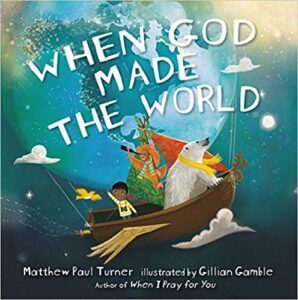 When God Made the World by Matthew Paul Turner
When God Made the World by Matthew Paul Turner My family loves Matthew Paul Turner’s previous books, When God Made You, When God Made Light and When I Pray for You. I love to use these titles to teach preschoolers and early elementary in a church setting. When I consult I recommend these titles for churches that are updating their church nurseries. When God Made the World delivers the thoughtful, inclusive and nurturing look at creation and our place in it.
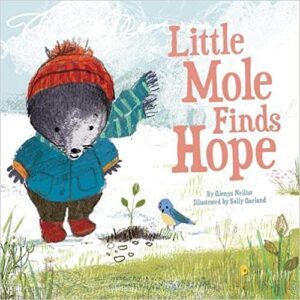 Little Mole Finds Hope by Glenys Nellist
Little Mole Finds Hope by Glenys Nellist Little Mole is struggling with sadness in his dark hole until his mother shows him how to look for new life and hope in his underground hole. I love Little Mole Finds Hope for the way that it talks about how hope emerges even from dark places and how to keep an eye out for hope in our world no matter how small.
 This is the Church by Sarah Raymond Cunningham
This is the Church by Sarah Raymond CunninghamA highly anticipated title from a trusted publisher in progressive faith, This is the Church looks at who makes up the church and how we relate. A great book for pre-schoolers and early elementary to explore community and what we do when we gather and go from the church.
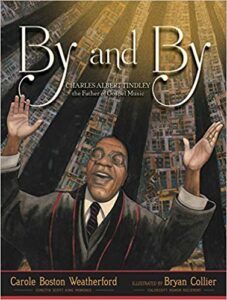 By and By: Charles Albert Tindley, The Father of Gospel Music by Carole Boston Weatherford
By and By: Charles Albert Tindley, The Father of Gospel Music by Carole Boston WeatherfordLate at night, Charles Tindley taught himself to read from scraps of newspapers. From those small scraps, young Charles raised himself to become a founding father of American gospel music. Offering a look at the history of gospel music and its impact on the church and history By and By is a unique book for children and adults to look more closely at the music that influences their faith.
 Prayers for Faithful Families: Everyday Prayers for Everyday Life by Traci Smith
Prayers for Faithful Families: Everyday Prayers for Everyday Life by Traci Smith I loved Traci Smith’s debut book Faithful Families so when I was contacted about her follow up book of prayers I literally squealed with delight at my inbox. Faithful Families is a book I pass out, recommend and give away all the time. Prayers for Faithful Families delivers the same lovely, thoughtful engagement for families in the form of prayers for the everyday. I love it and can’t wait to use it at the dinner table and with the littles at church. It would make a great gift for new parents or a baby dedication.
 All of a Sudden and Forever: Hope and Healing After the Oklahoma City Bombing by Chris Barton
All of a Sudden and Forever: Hope and Healing After the Oklahoma City Bombing by Chris BartonFifteen miles from the Alfred P Murrah Building in Oklahoma City my seventh grade English class shook once, and then twice with the aftershocks of the bombing. As a child affected by the Oklahoma City bombing and its aftermath I anticipate the release of All of a Sudden and Forever this year for deeply personal reasons. Tackling the themes of tragedy, hope and healing through the stories of that day, this book will be an excellent resource to pastors to talk about tragedy with young readers.
 The Cat Man of Aleppo by Karim Shamsi-Basha
The Cat Man of Aleppo by Karim Shamsi-Basha When war comes to Aala’s neighborhood, many of his friends flee to safety leaving their pets behind. Aala starts to care for the pets but as their numbers grow, he realizes he needs help. The Cat Man of Aleppo is an excellent story to illustrate the abstract concepts of the beatitudes–giving a modern story of what it means to be someone who thirst for righteousness, makes peace, shows mercy and mourn brokenness in the world.
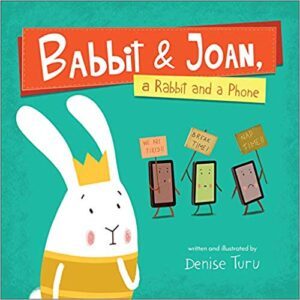 Babbit and Joan, A Rabbit and a Phone by Denise Turo
Babbit and Joan, A Rabbit and a Phone by Denise Turo I wanted to hide this book when I received it in the mail. I did not want my kids to read it because it was convicting for me as a parent. Babbit and Joan, A Rabbit and A Phone is about taking a break from phones and technology–think the day the crayon quit but with a phones on strike and a convicting message about setting down digital devices to create real connection.
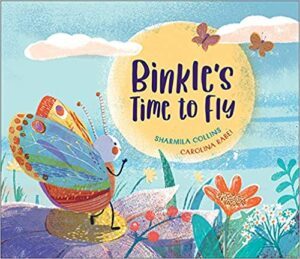 Binkle’s Time to Fly by Sharmila Collins
Binkle’s Time to Fly by Sharmila Collins Binkle is a caterpillar that cannot wait to be a butterfly, only to discover once he grows his wings that it’s going to take some adapting and innovation to finally fly. Binkle’s Time to Fly is a sweet story about overcoming challenges that would be an excellent resource for talking about how we work together to overcome obstacles (think of the scripture where the friends lower their sick friend through the roof).
If you are interested in other books to shape the faith of the kids in your life you can read my list of 20 Children’s Books to Enrich Young Faith or 11 More Books to Enrich Young Faith. I also have a list of books to help children with grief and emotional intelligence you can check out. What can I say, we love to connect storytelling to the stories and values of our faith!
Like what you’ve read? Want more? Sign up for my twice a month newsletter (because we’re not spammy) and get original content you can’t find here on the blog. Reflections on faith and living, book recommendations and other good, nerdy fun. Sign up HERE.



